Capt. William J. Forrest
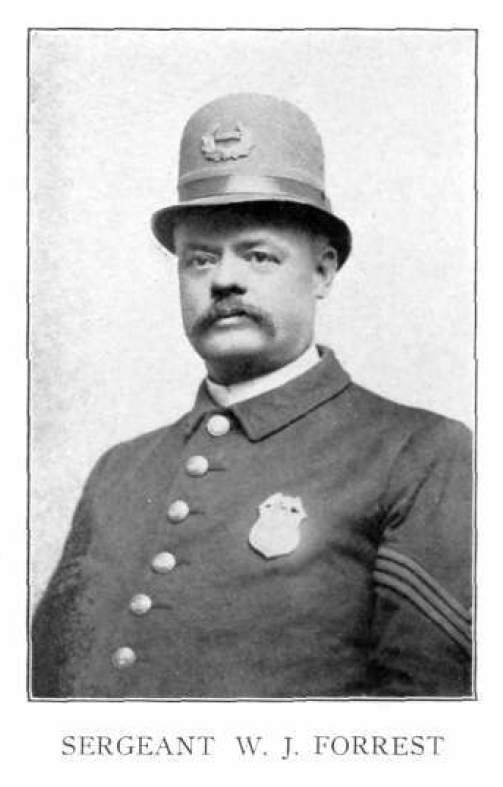 Sgt Wm. Forrest 1907 (The Father)
Sgt Wm. Forrest 1907 (The Father)
It turns out that there are two entrance on duty dates, making this a father and son team even though it was presented to me as though it were just one person. The son, who is still alive, has served for almost 50 years—exactly 46 years and 8 months. We'll go backward from Inspector Forest's "Final Roll Call" to determine when his career began. This may be the longest-serving police officer our department has ever had, according to his nephew, according to the obituary published in the Baltimore Sun in March 1967. This may have been accurate at the time because he did serve for about 46 years before retiring at age 70 or older. Better yet, we have a son who has continued in his father's footsteps and is doing what every father desires. He has outperformed his father's stellar performance on the force and has gone on to become one of the longest-serving police officers, rising from Patrol to Inspector and working from a time when horses and wagons were used to a time when automobiles were used, and before he left the K9 unit was in operation.
There is a report that he was mentioned in when he was being considered for promotion to sergeant in 1897. (At the time, you had to have either 3 or 5 years on patrol to be considered for sergeant; if we choose the lesser of the two and say 3 years, then consideration in 1897 would have meant he had been on since 1894.) Inquiring about it for me, Bobby Brown came up with a start date for the father of 1888 and a promotion date of January 12, 1903
In 1904, the father appeared twice in the Sun Paper, both times as a Sergeant; the first time was on May 30 and the second time was on October 28. He is photographed and identified as a Sergeant in the 1907 Blue Book "Baltimore Police History."
When he was promoted to sergeant on 5-8-1918 and to lieutenant on 6-1-1922, his son in 1911 followed in his footsteps. The son who is featured in the newspaper in 1922 is this (article below) Between 1918 and 1922, Wm. J. Forrest Jr. received a promotion of round sergeant. William J. Forrest Jr. is mentioned as a Captain in the Sun Paper in 1946, and as an Inspector in 1955. He stopped working in 1956, and he died in 1967. Inspector William J. Forrest Jr. received 16 commendations during the course of his 46-year tenure with the force, including 4 in 1922, 7 in 1923, 4 in 1924, and 1 in 1925.
These were some of the accounts that were found or sent to us, albeit the Father and Son would appear in the news more frequently than what you will see on this page. We'll make an effort to distinguish between the reports for the father and the son. The son's career is represented by these articles, which date from 1922, 1930, 1946, 1955, 1956, and 1967. The story stated that Inspector Forrest was being honored by the City at a luncheon in the 1956 article, specifically on August 21, 1956. The Inspector Forrest was initially thanked by the Baltimore Sun for his approximately 46 years of loyal service, which would have put him close to 70 years old at the time of his retirement.
Between father and son, they witnessed significant advances in the field of law enforcement; the father joined in 1888, the year the Mounted unit was established, and the son left in 1956, the year the K9 unit was established. One witnessed the era of wagons and Bobby Caps, as well as the emergence of the best K9 unit in our country and possibly the entire globe. the horrors in police enforcement that this family witnessed.
The Sun Passed, who was born in 1876 and died in 1967, was 91 years old. He is survived by his wife, Nettie Lockwood Forrest; their daughter, Miss Frances Forrest; two brothers, Julian I. Forrest and Carroll Forrest, both of whom retired as majors from the Police Department; and a sister. Mrs Helen Meyers, a Baltimore resident. I don't know how long he was online, but I'll post everything that has been emailed to me and that we have discovered so you can see for yourself.
The Reports of Both the Father and the Son are Listed Here
1967 – 5 Mar, 1967 Tuesday at 10 a.m., at the Immaculate Conception Church, Baltimore and Ware avenues, will be held a high mass of requiem for William J. Forrest, a retired inspector with the Baltimore City Police. Towson. After suffering a stroke a month earlier, Mr. Forrest, who resided at 333 Dixie Drive in Towson, passed away Friday night at Franklin Square Hospital. After serving in the Police Department for 48 years, Mr. Forrest took his inspector retirement in 1956. He oversaw several police activities as an inspector, including those at the Pine Street station, Southwestern, Southern Pres, and Northwestern regions. Foot Patrolman's back. The foot patrolman, according to a police administration or Mr. Forrest of the old school, is the core of the police force. As opposed to radio patrols, he said. Patrol officers on foot are familiar with their beats. After starting out as a foot patrolman in 1911, Inspector Forrest advanced to the positions of sergeant, round sergeant, lieutenant, and captain before being named an inspector in 1946. He organized a cleaning squad to check rooming houses to make sure they complied with the city housing code as one of his duties as an inspector. Over the course of his time with the Baltimore Police Department, he got 9 commendations for his work in capturing murderers and burglars. The former Nettie Lockwood, his wife, Miss Frances Forrest, two brothers, Julian I. Forrest and Carroll Forrest, both retired majors in the Police Department, and a sister round out his survivors. Mrs Helen Meyers, a Baltimore resident. It (The Son)
1956 – Inspector William J. Forrest Jr. was profiled in a 1956 piece in The Baltimore Sun Paper. In the article, he is congratulated for his nearly 46 years of "loyal" service. Let's keep track of the years he spent as a Police Sergeant, Round Sergeant, Lieutenant, Captain, and finally Inspector so that we can either have documentation of his start date or have enough evidence to determine it. First Sun paper's report on the City honoring Inspector Forrest at a luncheon, where on August 21, 1956, the Baltimore Sun begins its report by thanking the Inspector Forrest for his almost 46 years of faithful service. They then introduce some of those in attendance, such as Mayor D'Alesandro. They also mention the police commissioner (James Hepbron), along with many other City and State officials, of various ranks ranging from Patrolman to Chief I. On this day, the Emerson Hotel Ballroom was completely full just after noon. At age 70, no one has served as a Baltimore police officer for a longer period of time than Inspector Forrest, who rose through the ranks on his own. At the head table, where the guest of honor was seated beside his wife and daughter, Miss Frances Forrest, Anselm Sodaro, State Attorney, served as Toastmaster. No "Primary speaker" was present, but it was anticipated that many police officers would join the Mayor in reminding the inspector that it was "his" day. It was time to offer a gift, the nature of which was kept a mystery. All of the police department's employees contributed to its success. Baltimore's auxiliary bishop, Jerome J. Sebastian, will lead the prayer. Police Inspector Bernard J. Schmidt was in charge of making the luncheon preparations. (Side Note: From 1961 to 1966, Bernard Schmidt served as Baltimore's police commissioner. A young patrolman entered the elevator early in PC Schmidt's stint as Police Commissioner, and after a few floors the PC turned to the young officer and inquired whether he knew who he was. Although he apologized, the young man claimed he was unaware. It's fine, according to PC Schmidt, and he understood. Pictures of the Commissioner were hung in roll call rooms of all 9 districts shortly after that day in the elevator so that everyone would know what the PC looked like. Returning to 1956, The luncheon was held and was a complete success. except for the statement of the 46-year service... - So let's start (The Son)
1955 - A report on a use-of-force allegation against two patrolmen was published by the Sun Paper in 1955. (9 Aug 1955) According to reports, Inspector Forrest (then known as Police Inspector William J. Forrest) was tasked with looking into allegations that two Southwestern police officers brutally beat a guy they had apprehended the Friday before 5 August 1955. Disorderly conduct was alleged against the subject. The patrolmen who are accused produced the investigation reports. According to Inspector Ford, Benjamin Leddon and Charles Butka have not yet been provided. He stated that Inspector Forrest will have access to all official reports whenever they are received for use in his inquiry. John Minnick, 27, of the 1000 block of West Lombard Street, the alleged victim of the assault, was taken into custody after police were called to break up an altercation at a bar in the 1100 block of West Pratt Street. Unmarked 1 Witnesses claimed the brawl never started when he entered, yet Minnick was there! arrested outside on the street. In testimony given at a hearing held on Saturday morning in Southwestern Police Court, it was revealed that Minnick was unmarked when he boarded the police car for the three-block ride to the station, but that when he was later spotted there, he was nearly unrecognizably changed. Authorities said that Minnick needed hospital treatment, and the accused patrolmen claimed that Minnick's attempt to take Patrolman Leddon's gun led them into a fight. Throughout the struggle, one police officer was hurt. On allegations of assaulting the two cops, Magistrate Howard L. Aaron fined Minnick $25 for disorderly conduct, deferred the fee, and sentenced him to 30 days in jail. Submitted on August 9, 1955 (The Son)
1946 - According to the newspaper, Captain William J. Forrest was promoted to Inspector in 1946, and two police Lieutenants were made Captains. (10 Jan 1946) Inspector Forest will be given direction of the Southern and Central Districts, it continued. Lieut. Thomas S. Dunn of the Northeastern District will take over command of the Southwestern District to cover the void left by Capt. Lawrence King's recent retirement, while Lt. Alfred Cormack has been nominated to succeed Inspector Forrest as captain in the Northwestern District. Eight districts in the city will now be divided between four inspectors, according to Commissioner Atkinson, who filled the fifth inspector job created by the previous Legislature. Inspector John H. Mintiens will be in charge of the Northwestern and Northern districts, while Inspector John R. Schueler will be in charge of the Western and Southwestern districts. Inspector Joseph H. Itzel will command the Eastern and Northeastern districts. Inspector M. Joseph Wallace serves as chief. It (The Son)
1930 - In the arrests of two robbery suspects who were allegedly responsible for robbing a luncheon owner of $11 under threat of violence in early December 1930, he was identified as a Lieutenant. These two desperate individuals were taken into custody by the gallant Lieutenant's troops in a total of 15 minutes. John Furman, the owner of a lunchroom in the 1100 Block of Haubert Street, was the victim in this case. Around 10 o'clock in the morning, two armed guys entered, one of whom pointed a gun at him and demanded his daily salary. Furman gave them everything he had, which was about $11 dollars (his startup money, as this is a luncheon and the Robbers came in well before lunch time, they only got startup money for the day). Patrolmen John Peters and Martin Contey of the Southern District were able to apprehend and detain the men. The two men arrived at the station and gave their names as Earnest Frost, 24, and Delmar Bull, 22, both of whom were sailors (this was a problem in Baltimore since the city's founding as a port city, when criminals would enter on ships, commit crimes, then either get back on the boat to leave the city or a criminal transient simply move about the city without a trace). In this case, the police found $11 on one and a pistol on the other. The owner of a deli in the 4700 Block of Gwynn Oaks Avenue, Max Feldman, complained to the police that two men had robbed him of $20 the previous evening while holding a gun to his head. This occurrence is described in the second, titled Robbed at Gun Point. Feildman claimed that one of the males, who was about 25 years old, entered the store and asked for a sandwich before a second man pulled out a gun and ordered him to the back room. The $20 was then taken by the two from the cash register. A man attempted to take an automobile from William T. Sherwood, the night manager of the Guilford garage at Calvert and 34th Street, at around 10:30 last night. As Sherwood tried to stop the man, the man produced a gun, according to Sherwood. Sherwood made a wise retreat and let him go (without the automobile) One of those arrested had a diamond filling in his tooth, which was apparently used to saw through the bars to freedom (I guess you could say they chewed their way out), and the three had sawed their way out of the Frederick City Jail, according to the City Police. And now we hear more about our illustrious Lieutenant Williams, as Mr. Friedman saves $300 by picking it up off the floor of the Callow Ave Streetcar on which th When stealing the entire amount from the grocer's pocket, one of the criminals dropped the stolen goods on the ground. Mr. Freidman was jostled during the robbery so that he wouldn't notice a hand slipping into his suit coat's interior pocket. Because of how rough the jostling was, Mr. Friedman was going to ask the two men—one in front of him and the other behind him—to stop when he saw the money on the car's floor. Also, he observed that his bank book was missing and his pocket was empty. Following the heist, there was a struggle; Me Friedman grabbed the closest burglar, the second burglar joined in, and the three burglars got off the streetcar at Liberty and Redwood Streets. Two $50 bills from the $300 Mr. Friedman had salvaged fluttered to the ground as they plummeted to the sidewalk. The two robbers fled as Mr. Freidman stopped to collect the cash; one fled east on Redwood Street and the other fled west on the same block. Patrolman's case, Three males got out of the trolley while 18-year-old cab driver Anthony Aquilla was sitting in his parked vehicle close to the car stop. He phoned a patrolman named Mr. Friedman, who hopped in a cab and chased the pickpockets east on Redwood until he got lost in the chaos at Charles Street. Then Mr. Friedman, who resides at 1233 South Cary Street, traveled to the Western District and shared his tale with Lieutenant William J Forrest and Captain John S. Cooney. As a result, from this we learn a little about the historical context and discover that in 1930 Inspector Williams was a Lieutenant (The Son)
1922 – A 200-gallon still, a 100-horsepower boiler, 18 50-gallon fermenters, 500 pounds of rye meal, and eight gallons of moonshine were allegedly found during a Southern district police raid on 415 South Hanover Street on September 20, 1922, led by Lieutenant William J. Forrest and Sergeant Clarence C. Kendall. They detained 125 West Barre Street residents Albert Leuba and Arthur Chicks, who were then given to Edward J. Lindholm, the deputy internal tax collector, who seized the illegal enterprise. Leuba and Chicks were charged and detained for a hearing on September 29th before J. Frank Supplee Jr., a United States Commissioner. After appearing before the Commissioner for a hearing on the allegations of making and having alcohol, J. Hall and Chester E. Nolas of Rising Sun, Maryland, were granted release on bail until court. Charges were brought after a 200-gallon still was found at Rising Sun. Palmer C. Rakes, who was also detained, was kept in custody on a separate charge of impeding and resisting an officer. The prosecution against Norman A. Clark, whose residence was listed as 543 Wayne street, was allowed a continuance. He was accused of being the main distiller at Earleigh Heights in Anne Arundel county, where a 1,000 gallon still was discovered. William Woods and M. Carenda are named as suspects in the arrest warrant. An arrested black man named David King later testified for the government. Delmar Sutphin and Edward Wilkins, of Hising Sun, Russell Torres, and Herman Constantine, all of Baltimore, and Joseph Feriara, who was accused of making and having alcohol, were all freed on bail pending their court appearances. It (The Son)
1907 – The Baltimore Police Department's history, from 1774 to 1907 William J. Forrest is listed as a Sergeant on Page 56 of the original book published in 1907, with a photo of him in that position. However, at the time, in order to qualify as a Sergeant, one had to have served in the Patrol for at least three years. While he is listed in the 1907 book, which would make him a member since at least 1904, other news articles list him as a Sergeant in 1904, which would put him in the news in that year, Considering that he joined in 1894, his first year, and that it was his first opportunity for promotion... If he joined the military at the age of 21, served for 62 years, and retired in 1956, he would have been 83 years old, not 80 as previously thought. We already know that the newspaper's 1911 start date for him was inaccurate; according to their own articles, he was actually on in 1897, 1904, 1907, 1922, 1930, 1946, 1955, and 1956. The key issue at hand is whether the three-year rule was in place, and if so, whether he began in 1894 or 1895. (The dad)
1904 – The Baltimore Sun published an article headlined "Policemen Transferred" on October 28, 1904, the year of the Great Fire, with the subtitle "Sergeant Carberry Moved to Northwestern District." "The Following modifications were made yesterday, October 27, 1904, by the Board of Police Commissioners: Sergt. William J. Forrest Northwestern to Central," it said at the outset. It then goes on to list a further 7 Sergeants or patrolmen who were moved around. Sergt. Carberry's case was heard by the board shortly before the amendments were implemented, and this led to the adjustments being made "for the good of the Department." Three patrolmen who were expelled from the Central District belonged to Sergeant Carberry's squad and gave testimony against him in court. The men had a lot of emotion, therefore it was decided at the hearing that it would be best to separate them. William L. Thomas, a patrolman who testified against the sergeant, was permitted to stay in his jurisdiction. Probationary By board order, patrolman George J. Will of the Western district was promoted to regular patrolman, and Alexander H. Hobbs was made a probationary patrolman and assigned to the Central District. Detective Todd Hall also received $25 from Mr. Allen Mclane to help with the investigation into Mayor McLane's death. for the detective's assistance in looking into Mayor McLane's death. According to Detective Hall, the Mayor's passing happened by mistake. (The dad)
1904 – 30 May 1904 The Northwestern district was the target of two raids. Officers in ordinary clothing working under Capt. Schultz's command yesterday. Around 1:00 a.m., Round Sergeant Thomas Hood, Sergeant William J. Forrest, Patrolmen James E. Abbott and Harry Webster shocked the 19 customers, who were all people of color, by walking into George L. Jeannert's tavern at 589 Baker Street. It took two trips for the patrol wagon to transport all bands to the station. Jeannert was arrested by Justice Goldman on suspicion of selling alcohol on a Sunday. About midday, Patrolmen Robert T. Neal, Albert McLane, and Peter Coughlin of the Northern district searched Mrs. Kate Keaveney's tavern at 540 Dolphin Street. Five black people were standing in front of the pub when the officers arrived, and there was a dash for freedom. One sprinted through the house and jumped over the back fence to flee. With numerous beers in hand, the other four were driven to the station. Judge Goldman granted Mrs. Keaveney's release on bail in order to appear in court on the accusation of selling alcohol on a Sunday. (The dad)
1897 – Patrolman Plum's Promotion, 12 May 1897. The names of the patrolmen that Captain Baker determined to be eligible were compiled on a list the day before. It listed Plum, Miller, Forrest, Bishop, and Green by name. Plum was given by Commissioner Johnson. (The dad)
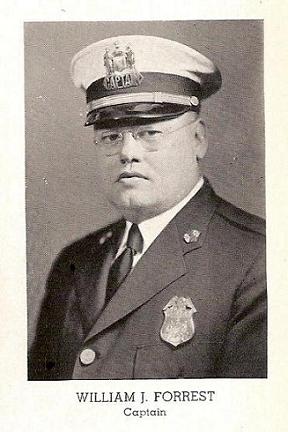
Captain William J Forrest Son
later promoted to Inspector
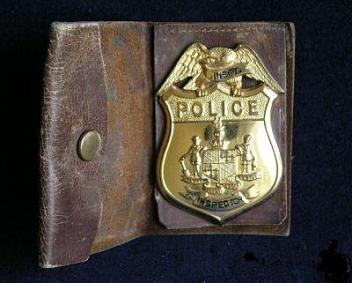 Original Inspector badge and case belonging to Inspector William J Forrest
Original Inspector badge and case belonging to Inspector William J Forrest
 The original badge issued to Inspector William J Forrest
The original badge issued to Inspector William J Forrest
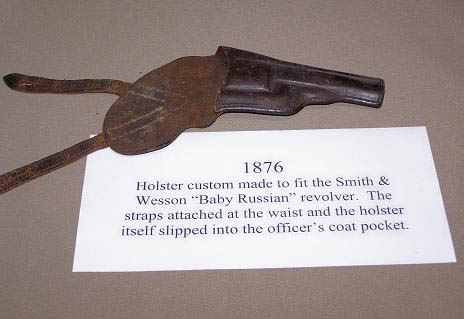
Although we can see that this isn't the same holster as the one for the same make and type of gun, we can also see that it was created by the same leather craftsman and that the area where the two straps meet is particular to each holster. Also, the text in the image reveals that this was built specifically for a Smith & Wesson "Baby Russian" a.38 Cal. Revolver was a weapon that our police frequently carried in the late 1800s and early 1900s; it's important to note that many of these officers carried their pistols in their pockets at the period, which is why a pocket holster was necessary. This extremely risky way of carrying a handgun has resulted in a number of major injuries, and even some fatalities.

The following are some holsters that Inspector Forrest once had.
The following two holsters were bought from a vendor of vintage leather goods, antique guns, and other police-related antiques. At the time of this post's publication (April 2014), The seller was selling them for Charles "Charlie" Klein, who was 84 years old, Charlie purchased them from his uncle William Forrest, a former inspector. The seller was selling them for Charlie.
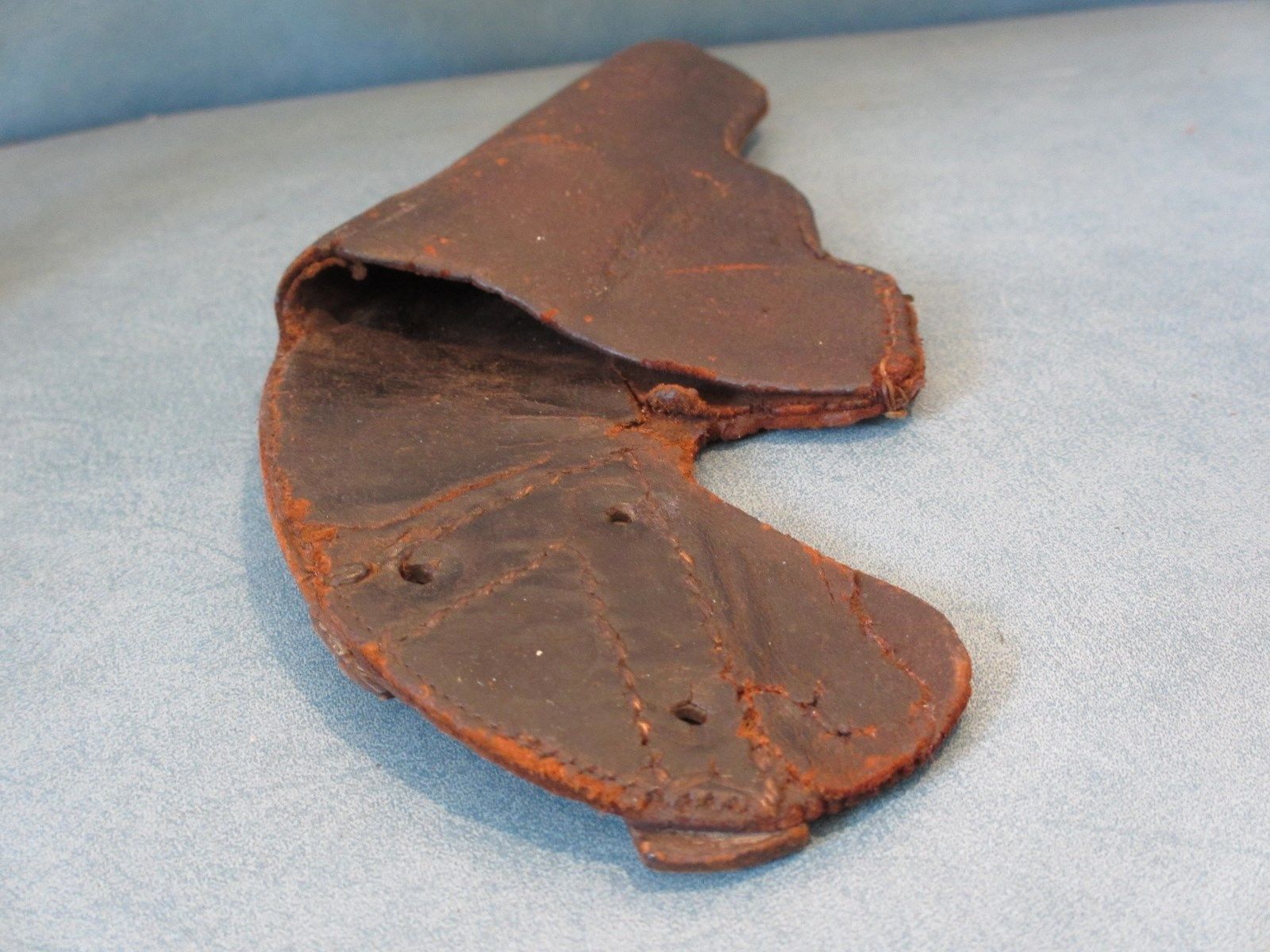 Pocket Holster from the Late 1800's early 1900's
Pocket Holster from the Late 1800's early 1900's
 Pocket Holster from the Late 1800's early 1900's
Pocket Holster from the Late 1800's early 1900's
 Pocket Holster from the Late 1800's early 1900's
Pocket Holster from the Late 1800's early 1900's
 Audley Safety Holster Pat. 13 Oct. 1914
Audley Safety Holster Pat. 13 Oct. 1914
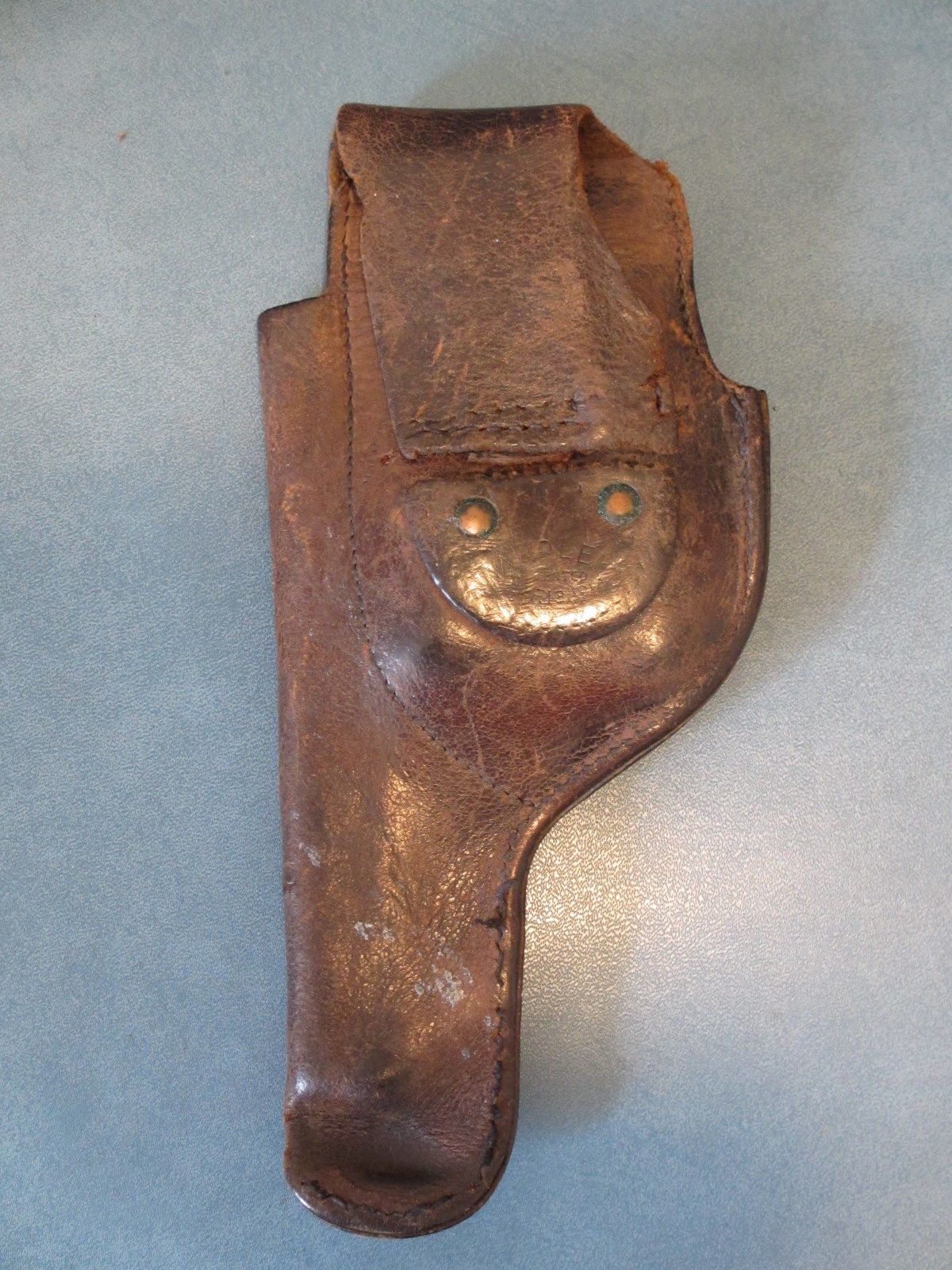 Audley Safety Holster Pat. 13 Oct. 1914
Audley Safety Holster Pat. 13 Oct. 1914
 Audley Saftey Holster Pat. 13 Oct. 1914
Audley Saftey Holster Pat. 13 Oct. 1914
 On the right we see the rear of the Audley Safety Holster Pat. 13 Oct. 1914
On the right we see the rear of the Audley Safety Holster Pat. 13 Oct. 1914
 On the right we see the rear of the Audley Safety Holster Pat. 13 Oct. 1914
On the right we see the rear of the Audley Safety Holster Pat. 13 Oct. 1914
F. H. Audley, a former saddle, harness, and boot maker, founded the Audley Safety Holster Company in the early 1900s, about 1905. He had honed these skills over the course of 30 years working in the saddlery and harness industry.
About 1876, F. H. Audley opened his own saddlery firm in New York at 2557 Third Avenue (around 139th Street), which he ran until 1885. After that, he shut down operations and joined Mr. P. H. Comerford in the saddlery, harness, and boot manufacturing industry. Frank H. Audley returned to business in 1891, but despite producing high-quality saddlery and boots, he suffered for the following ten years, right up until the turn of the century.
F. H. Audley started gaining a lot of exposure to police equipment when he moved his business to 8 Central Market Place, across from Police Headquarters, in the early 1900s. Since then, F. H. Audley has applied for numerous patents for a variety of police equipment that he produced and marketed to numerous New York City police officers who took advantage of his convenient location to use his services.
The Audley Safety Holster, for which F. H. Audley sought for patents in 1912 and received approval on October 13, 1914, is the most well-known of these creations. The body of the holster includes a spring-loaded steel latch that firmly holds the weapon in place. Only by depressing the catch with the index finger can it be let go. It is nearly impossible for anyone else than the wearer of the holster to accomplish this. Further holding straps are not necessary.
In World War One, many officers found them to be useful, and many American police departments also employed them. The Folsom Arms Co. acquired the Audley Company, which was then taken over by the Cortland Bootjack Co. before becoming the JayPee Holster Co. An officer who was mounted on a motorcycle or a horse during the 1920s and 1930s most likely utilized this specific type.
Francis H. Audley passed away in May 1916, and I just so happened to come upon a copy of his obituary from the New York Times on May 11, 1916.

POLICE INFORMATION
Copies of: Your Baltimore Police Department Class Photo, Pictures of our Officers, Vehicles, Equipment, Newspaper Articles relating to our department and or officers, Old Departmental Newsletters, Lookouts, Wanted Posters, and or Brochures. Information on Deceased Officers and anything that may help Preserve the History and Proud Traditions of this agency. Please contact Retired Detective Kenny Driscoll.
This email address is being protected from spambots. You need JavaScript enabled to view it.

NOTICE
How to Dispose of Old Police Items
Please contact Det. Ret. Kenny Driscoll if you have any pictures of you or your family members and wish them remembered here on this tribute site to Honor the fine men and women who have served with Honor and Distinction at the Baltimore Police Department.
Anyone with information, photographs, memorabilia, or other "Baltimore City Police" items can contact Ret. Det. Kenny Driscoll at This email address is being protected from spambots. You need JavaScript enabled to view it. follow us on Twitter @BaltoPoliceHist or like us on Facebook or mail pics to 8138 Dundalk Ave. Baltimore Md. 21222
Copyright © 2002 Baltimore City Police History - Ret Det Kenny Driscoll
You May Like



































